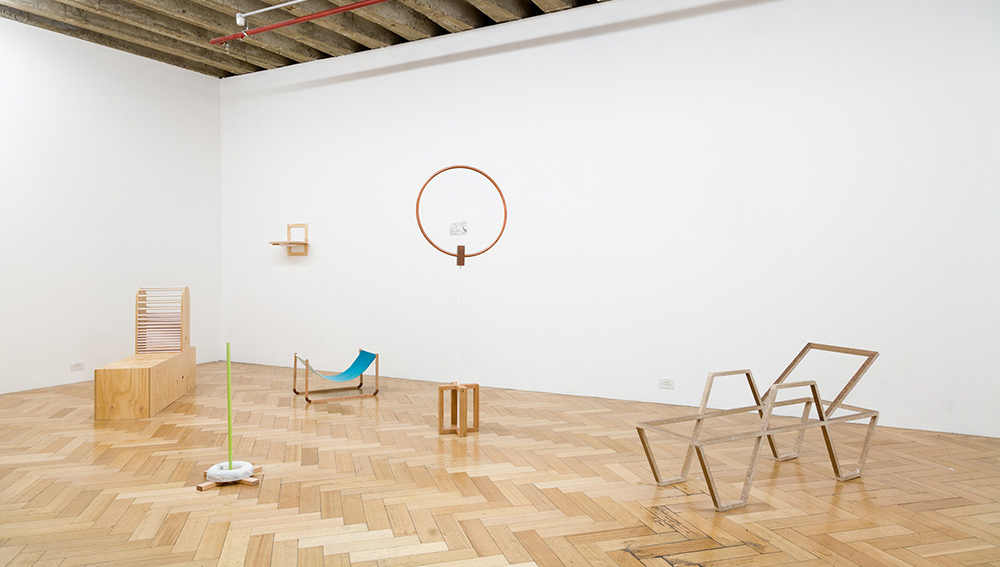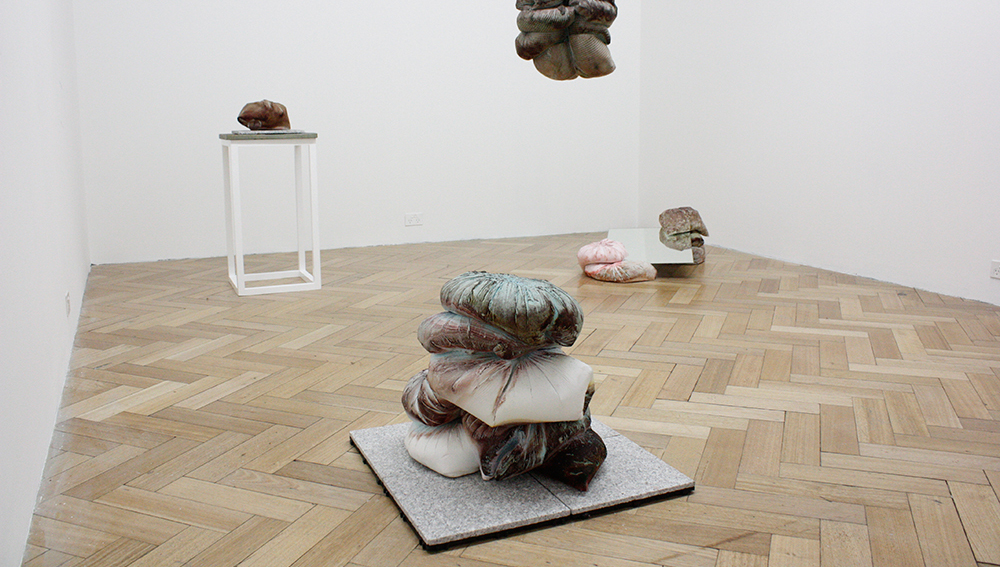West Space: beyond the walls
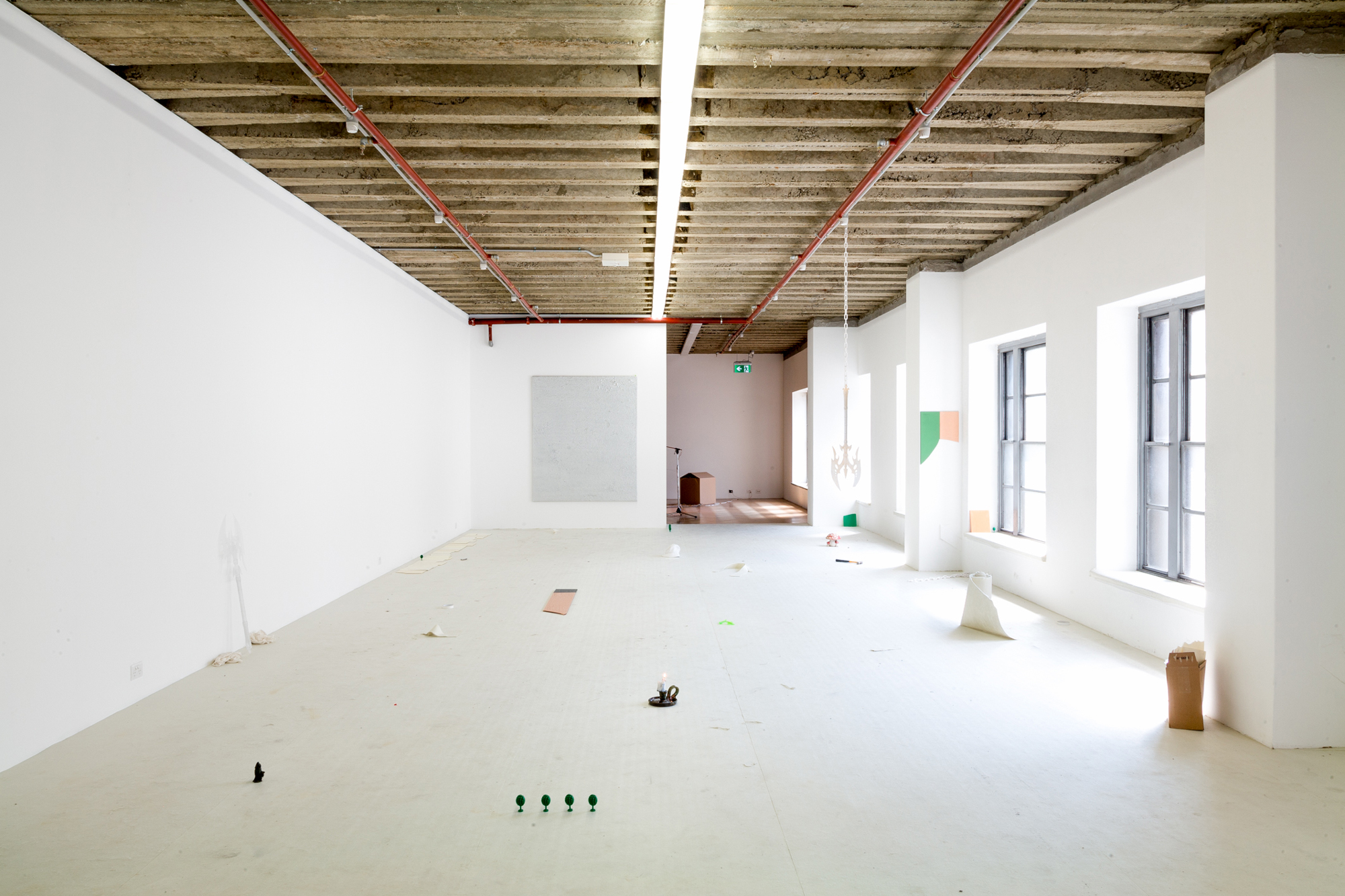
Founded in 1993, West Space began as a tiny artist-run space out west (hence the name) in Footscray, Melbourne. It is now in its fourth physical iteration in a John Wardle-conceived space on Bourke Street in the CBD, featuring a design that removes rather than adds, revealing and celebrating existing structural elements (such as the original 1940s parquetry floor).
As a not-for-profit artist-led organisation, West Space exists to facilitate artists’ practice in a critical context across all mediums. While it has grown much larger over the past 21 years, it hasn’t grown apart from its driving force: the artists it supports.
The annual West Space fundraiser is testament to the organisation’s ongoing dedication to the artist community (and the love the community has for West Space in return). It’s a rare opportunity for the public to experience Melbourne contemporary art en masse, and an easy, affordable, feel-good way to participate. This year over 150 artists (emerging and established) have donated work to be sold, the proceeds from which will be used to keep the space rent-free for exhibiting artists.
Two such artists are Brigit Ryan and Akira Akira, whose work, while very different, finds common ground in the intersection between art and design. Brigit’s exhibition with Brodie Wood, The Qualms, which took place in Gallery Two earlier this year, comprised a series of objects with functional resonances that presented intriguing spatial relationships both with each other and also the space itself. Akira’s upcoming exhibition in September, Shelves, Walls and Other Structures, will see him construct an ‘interior within an interior’, also featuring objects that imply practicality.
With this year’s fundraiser just around the corner, Assemble Papers Editor Rachel Elliot-Jones met with Brigit and Akira, along with West Space Director Danny Lacy, to talk about what it’s like to work within the unique physical space; how – despite its very special digs – West Space as an organisation transcends the walls that contain it; and why it’s important to support artist-run initiatives such as this.

Danny Lacy
Brigit – you’ve already had an exhibition at West Space. It would be good to hear your thoughts about how you were thinking about the space and how your work would take shape within the exhibition context.
Brigit Ryan
I really like West Space as entire space because you can see the history in the structure of the building. The parquetry floor fits well into my work because it refers to interior spaces, design, and the history of design. Relating my work to the actual space was really nice because most galleries don’t have those specific features you can bounce off and use. I played with camouflaging elements of my work with the geometry of the floor. One of my pieces rose up out of the ground and you could see it against the wall, but then if you were standing over it, it kind of disappeared. That was a big part of the appeal of the space for me.
Specifically, Gallery Two is interesting because it’s kind of enclosed but you can enter from three different angles, so I played with that as well. One of the works was a big ring that you could look through to one of my drawings from the main entrance, and at the back entrance there was another ring to look through from a different angle. We considered how, from all of those entry points, and then walking through, everything interacted – there were all of these viewpoints from which people could survey how the pieces work together.

DL Your practice is very object-based, but when you come into the gallery space it becomes very spatial as well – to try and articulate space between the objects and their interrelationship as people walk through.
BR Yes, and we also wanted to be a bit like a showroom, using the way you could move through from those different angles, which was quite fun. In retail spaces there are often different routes to take; the space pushes you through as a consumer, so we were playing with that idea as well.
Rachel Elliot-Jones
Reflecting back on it, did you find that that was achieved?
BR Yeah definitely! I found some really funny things. I walked into the space and someone had their head through one of the hoops. I loved that the work really did encourage people to respond – they seemed to get it, play with it. People kept saying “I want to put my coat through that hoop and hang it off there”, like a coat rack…
RE So, truly interactive?
BR Yeah, except, I mean, don’t put your coat on my work. (laughter)
DLI guess that’s the other thing about the pieces. They often alluded to other objects, so people felt a relationship with or an understanding of them, but you skewed that enough so people wouldn’t actually use them as a coat rack.
BR Yeah, definitely. It’s dealing with the way objects are designed and the things that are appealing or familiar in those objects, so they maintain some of those elements, but my works are not actually useable or functional.
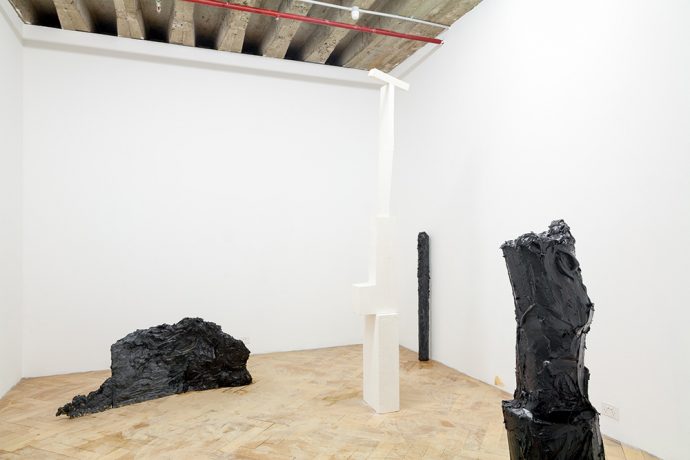

DL And Akira, you’re preparing for an upcoming exhibition in Gallery Two. What are some of things you’re thinking about or contemplating in terms of your work filling the space?
Akira Akira
I think this work, more so than my previous work, is quite site-specific. I’m even starting to make a bit of a mock-up of Gallery Two just to see how the structure that I’m making will fit and how that would feel. It’s one thing to make a certain measurement in drawings or CAD, and entirely another to see it in physical material. I’m trying to make that leap from drawing to object or structure-based installation work better – it’s something I’ve been thinking about a lot. Gallery Two is a tricky space, in that there are three entrances/exits. I’m making a three-prong freestanding wall, which will have a different vantage point from each entry point, and thinking about how that will affect the other objects I install within it.
DL This project extends the work you did in Japan at the Mori Art Museum…
AA Yes absolutely. Last year I exhibited in Tokyo and on that occasion I made a false ceiling and from there hung a number of objects or sculptures, as well as placing some plinth-like structures underneath. In a way, the logical step from a ceiling was to make walls… (laughter)… and that sort of became a primary objective. My process involved the practicality of making something that I can construct, assemble and deassemble – basically flat pack freestanding furniture or a freestanding wall. Trying to figure out how to do that in practice is quite a challenge but also quite fun.

DL I think that is one of the interesting things – everyone comes from a different background in terms of where their ideas for working in the space come from.
AA Yes, absolutely. I mean, just looking up at the ceiling – it’s such a prominent feature of the space, and also the floor. What happens between the floor and the ceiling is something that we engage with in different ways…
BR I find the ceiling, which is so dark and kind of looks dirty compared to the clean gallery walls, makes it feel like a bit of a set, which I don’t think people notice straight away. I definitely considered that when thinking about our show – how there is this clean space in the centre that is kind of constructed.
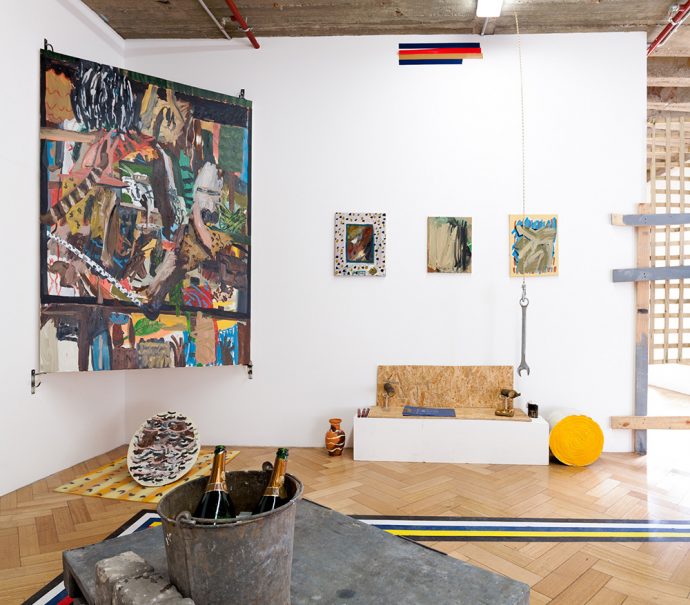
DL I think the really interesting thing about West Space in this Bourke Street premises is that it’s very self-contained. We’re across the entire first floor of the building, and John Wardle Architects really have got us as much possible space usage out of the whole level. Before we moved in here it was completely open-plan, so every wall has been constructed with quite a specific outcome in mind – all the walls are backed with plywood so they’re weight-bearing; there are storage cavities behind every wall so we can store books and materials.
We’ve continued the model from the previous West Space near Queen Victoria Markets, where we had three smaller spaces, to now having five gallery spaces of varying sizes that artists can propose to exhibit within. It’s such a great, warm environment to work in.
RE It does feel very unique. It almost feels undesigned, in revealing the structure beneath, rather than building what’s not there. There’s a simple harmony between the elements, whereas I think sometimes when you emphasise an architectural feature, such as the floor or the ceiling, it can overshadow the art exhibited within a space.

DL I think that’s the thing, the space is quite neutral in a way, so what you see when you come in is the artwork first and foremost. It’s a great platform for the work to take centre stage. That’s where the skill is in terms of getting the space right for people to view the work on display.
RE Which is intrinsic to the philosophy of West Space in providing a blank stage for the work to take shape.
DL Definitely, part of our ongoing approach is to give artists total creative freedom over their practice here. Now that we’re rent-free for artists as well, there isn’t that burden of extra cost, which instead can be put back into their practice. We have 24/7 access for artists when they’re installing. We try to facilitate and be as supportive as possible and help artists to realise their projects.
RE And even though you’ve got this beautiful John Wardle-designed space, which is great, there is the notion that West Space is not necessarily tied to a particular location and is nimble enough to exist and facilitate no matter what.

DL I think West Space is in a really great position because we do feel quite light. This is the fourth venue that West Space has been in, so the idea behind the organisation is something that has built over the last 21 years; that’s the core of our organisation more so than the physical space. We can move if we have to, we can do offsite projects, we’re not bound by a physical space – even though that’s obviously quite intrinsic to the outcomes that are presented here.
I think the important thing for us is that we stay true to our core, which is the artists we’re supporting. They range from emerging artists – people who are just graduating over the last couple of years – to more established artists who have been practising for 30 or 40 years. It’s really important to us to have a conversation between generations, and we’re not medium-specific at all.
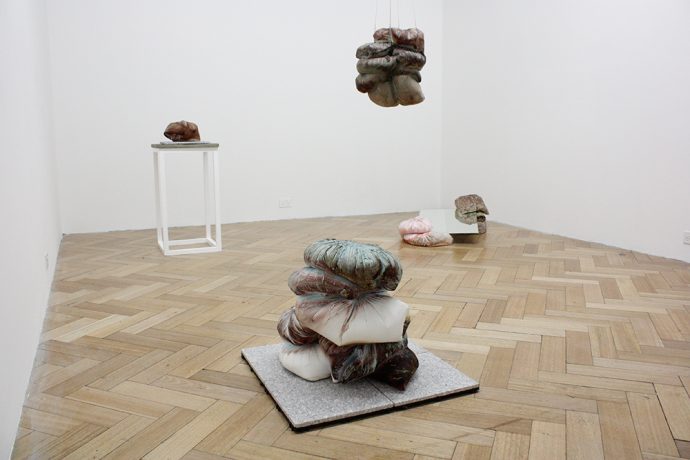
RE Brigit and Akira, you’re both involved in the upcoming West Space fundraiser, along with over 150 other artists. Why did you think it was important to participate?
BR I’m an emerging artist very early in my career and to be involved in a gallery that also has relationships with established artists and that truly supports us all is really great. I would love to contribute to keeping the space rent-free, apart from just really loving the space and wanting to exhibit.
AA I think the fundraiser is a really nice way to see the real cross section of artists living and working in Melbourne and it’s testimony to what West Space is and has become; the range of artists who are prepared to contribute in this way is quite incredible.

RE And considering it from the audience perspective, I think for people who’ve considered buying art in the past but who’ve perhaps been intimidated by the possibilities and not known where to start, the fundraiser is a really great way of taking that first step because you feel like you’re part of something bigger. Whatever move you make is going to have a dual benefit.
DL Definitely. It’s an entry point into the contemporary art world of Melbourne; a great snapshot of what’s happening now. We have works that range from $5 to thousands of dollars, and from artists such as John Nixon, Peter Tyndall, Emily Floyd – people who have been practising for years and years – alongside more emerging artists just out of uni.
RE It’s almost unfathomable to imagine everyone in a room together.
DL It really does hit home when you can see our office completely filled with all these amazing artworks ready to go for the one week we have the fundraiser on. It really articulates our vision and what we’re all about – it’s about being artist-run, artist-focused, and artist-funded as well, which is what the fundraiser allows us to do.

Huge thanks to Brigit, Akira and Danny for their time. Assemble Papers is proud to be a media partner to the upcoming West Space fundraiser, which opens to the public on Tuesday 17 June. We hope to see you there! For more information about the fundraiser and the upcoming West Space program visit: westspace.org.au


